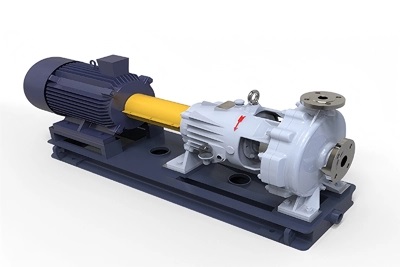In the petrochemical industry, process pumps are an essential type of conveying equipment, widely used in crude oil processing, petrochemical product production, and various chemical processes. Choosing the right process pump is crucial for the operational efficiency and safety of the entire production system. The selection of a process pump not only requires consideration of its performance and technical standards but also a comprehensive evaluation based on process requirements, medium characteristics, and safety demands. This article will explore how to scientifically and reasonably choose process pumps suitable for the petrochemical industry, starting from different types of process pumps and selection criteria.
Medium and light duty process pumps are suitable for conveying some non-explosive, moderately toxic, or slightly toxic media. The design and manufacturing standards for these types of pumps are relatively lower, resulting in more economical costs and relatively lower reliability requirements.
Applicable Media
Medium and light duty process pumps are suitable for some relatively safe chemical media, such as conventional petroleum products, solvents, and non-explosive liquids. These media have relatively low requirements for the pumps working conditions.
Design Standards
These pumps usually adopt the ASME B73.1M/B73.2M standards, which specify the performance requirements, structural design, corrosion resistance, and sealing methods for axially split chemical process pumps. The design of medium and light duty process pumps emphasizes economic factors, so their material, design, manufacturing, and testing requirements are lower than those of heavy duty process pumps. Although their reliability is not as high as that of heavy duty process pumps, they are sufficient for use in most regular chemical environments and are relatively inexpensive.
Common Applications
These types of process pumps are commonly used to convey non-explosive, slightly toxic media. They are suitable for some conventional petrochemical production lines, such as preliminary petroleum processing, gas separation, and the transfer of some non-corrosive liquids.

Heavy duty process pumps are usually used for conveying highly hazardous media, especially in scenarios where strict safety risk control is required. Their design standards are higher, allowing them to withstand more demanding working conditions.
Applicable Media
Explosive Media: For example, flammable and explosive liquids or gases.
Highly Toxic or Dangerous Media: Such as highly toxic chemicals or highly polluting waste.
Design Standards
Heavy duty process pumps have higher requirements in terms of design, material selection, manufacturing standards, and testing requirements. The design standards they adopt usually meet stricter international or industry safety regulations, capable of preventing dangerous media leakage and ensuring long-term stable operation.
Common Applications
Heavy duty process pumps are mostly used for conveying highly hazardous media in the petrochemical industry, such as some highly toxic and explosive substances involved in deep petroleum processing, or in chemical processes that operate under high temperature and high pressure conditions. They have very high requirements for reliability and safety and can ensure normal equipment operation under complex and harsh working conditions.
In the petrochemical industry, the selection of process pumps is directly related to production efficiency, cost, and safety. By selecting the appropriate api pumps types based on medium characteristics, working conditions, and safety requirements, it is possible to ensure equipment reliability, reduce costs, and avoid unnecessary risks. During the actual selection process, a detailed understanding of the characteristics of different standard process pumps is required, and scientific decisions should be made based on specific needs to ensure the optimal performance of the pumps.